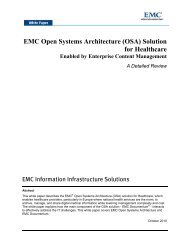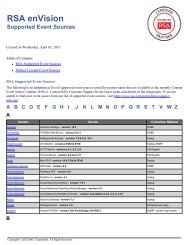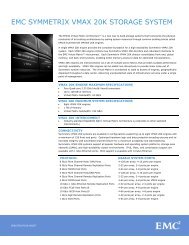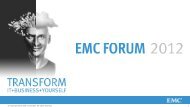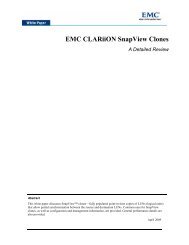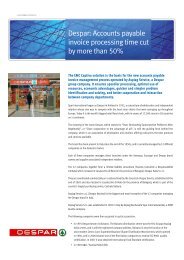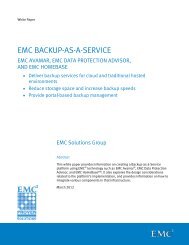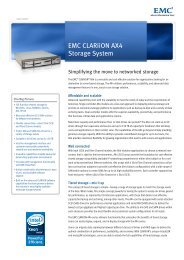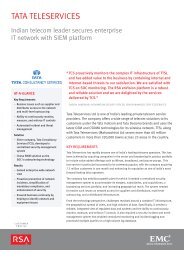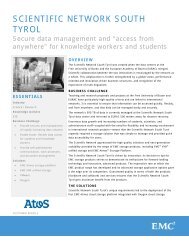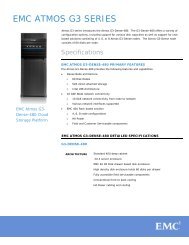EMC Backup and Recovery for Oracle 11g OLTP Enabled by EMC ...
EMC Backup and Recovery for Oracle 11g OLTP Enabled by EMC ...
EMC Backup and Recovery for Oracle 11g OLTP Enabled by EMC ...
You also want an ePaper? Increase the reach of your titles
YUMPU automatically turns print PDFs into web optimized ePapers that Google loves.
Chapter 3: Storage Design<br />
Data Domain<br />
Overview The following sections describe how Data Domain systems ensure data integrity <strong>and</strong><br />
provide multiple levels of data compression, reliable restorations <strong>and</strong> multipath<br />
configurations. The Data Domain operating system (DD OS) Data Invulnerability<br />
Architecture protects against data loss from hardware <strong>and</strong> software failures.<br />
Data integrity When writing to disk, the DD OS creates <strong>and</strong> stores checksums <strong>and</strong> self-describing<br />
metadata <strong>for</strong> all data received. After writing the data to disk, the DD OS then<br />
recomputes <strong>and</strong> verifies the checksums <strong>and</strong> metadata. An append-only write policy<br />
guards against overwriting valid data.<br />
Data<br />
compression<br />
After a backup completes, a validation process looks at what was written to disk to<br />
see that all file segments are logically correct within the file system <strong>and</strong> that the data<br />
is the same on the disk as it was be<strong>for</strong>e being written to disk.<br />
In the background, the Online Verify operation continuously checks that data on the<br />
disks is correct <strong>and</strong> unchanged since the earlier validation process.<br />
The back-end storage is set up in a double parity RAID 6 configuration (two parity<br />
drives). Additionally, hot spares are configured within the system. Each parity stripe<br />
has block checksums to ensure that data is correct. The checksums are constantly<br />
used during the online verify operation <strong>and</strong> when data is read from the Data Domain<br />
system. With double parity, the system can fix simultaneous errors on up to two<br />
disks.<br />
To keep data synchronized during a hardware or power failure, the Data Domain<br />
system uses NVRAM (non-volatile RAM) to track outst<strong>and</strong>ing I/O operations. An<br />
NVRAM card with fully-charged batteries (the typical state) can retain data <strong>for</strong> a<br />
minimum of 48 hours. When reading data back on a restore operation, the DD OS<br />
uses multiple layers of consistency checks to verify that restored data is correct.<br />
DD OS stores only unique data. Through Global Compression, a Data Domain<br />
system pools redundant data from each backup image. Any duplicate data is stored<br />
only once. The storage of unique data is invisible to backup software, which sees the<br />
entire virtual file system.<br />
DD OS data compression is independent of data <strong>for</strong>mat. This can be structured, <strong>for</strong><br />
example, databases, or unstructured, <strong>for</strong> example, text files. Data can be from file<br />
systems or raw volumes. Typical compression ratios are 20:1 on average over many<br />
weeks. This assumes weekly full <strong>and</strong> daily incremental backups. A backup that<br />
includes many duplicate or similar files (files copied several times with minor<br />
changes) benefits the most from compression. Depending on backup volume, size,<br />
retention period, <strong>and</strong> rate of change, the amount of compression can vary.<br />
Data Domain per<strong>for</strong>ms inline deduplication only. Inline deduplication ensures:<br />
• Smaller footprint<br />
• Longer retention<br />
• Faster restore<br />
• Faster time to disaster recovery<br />
<strong>EMC</strong> <strong>Backup</strong> <strong>and</strong> <strong>Recovery</strong> <strong>for</strong> <strong>Oracle</strong> <strong>11g</strong> <strong>OLTP</strong> <strong>Enabled</strong> <strong>by</strong> <strong>EMC</strong> CLARiiON, <strong>EMC</strong> Data Domain, <strong>EMC</strong> NetWorker,<br />
<strong>and</strong> <strong>Oracle</strong> <strong>Recovery</strong> Manager using NFS Proven Solution Guide<br />
23




